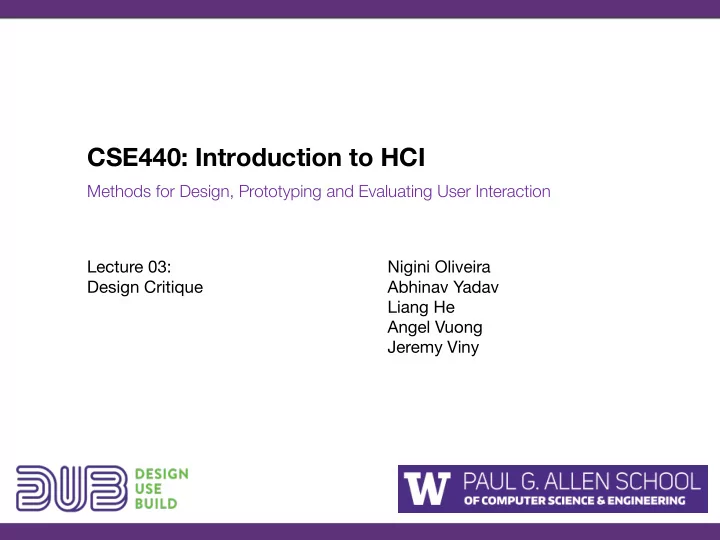

CSE440: Introduction to HCI Methods for Design, Prototyping and Evaluating User Interaction Lecture 03: Nigini Oliveira Design Critique Abhinav Yadav Liang He Angel Vuong Jeremy Viny
What about Friday Section?
What do you want to improve? Help travellers to connect with their families and we all to sleep better Balance out the amount of time children and others spend on digital devices and gaming Increase awareness of consuming footprint Cook at home and eating healthier Make commuting faster and driving safer Help communities that need outdoor installations and social encounters Manage time and health for students and content (sometimes harmful) for readers Support people on taking care of their loyal companions: plants and pets
Week Calendar
Design Critique
Why critique? Critique helps evaluate early, often, and cheaply Applicable to artifacts of many types Compare to other expert inspection methods You are not your own worst (best!?) critic We collectively know more than any one of us It is hard to see past your own decisions Design requires getting past our own infatuation
Why critique? You will encounter critique in many other disciplines visual art, writing, design, code (i.e., code review) Over time, you should gather people who can give you high-quality critique in everything you do You may meet some of those people in this class!
Critique is about improvement alistapart.com/article/design-criticism-creative-process
What is critique? Critique is a method for feedback It is not just a list of complaints 1. Presenters sit down with critics 2. Quickly explain their artifacts and their feedback needs 3. Critiques ask clarification questions, then give feedback 4. Presenters respond to questions and take notes on what is discussed
Critique is not criticism! Seriously, not just a list of complaints Critiques offer honest feedback Both positive and negative Presenters should be able to learn what works well and what is problematic about their artifact It is then presenter’s responsibility to sort through feedback, decide what is important, and how to act You must take notes for later review
Common issues in critique feedback Lack of Clarity Taking it Personal Design Apathy Contradictions Indecisiveness Resistance Too much Negativity (McDaniel)
Tips for those receiving feedback Taking advice is not giving up authorship You still make the final decision A half-baked suggestion does not contain all the details of a finished solution Design your critique What you show invites different forms of feedback Verbally indicate what kind of feedback you want, but also provide an artifact of appropriate form This course will guide you what feedback you invite at which stage
Tips for critics Hamburger method: Bun: something fluffy and nice Meat: Criticism on how to improve Bun: Something fluffy and nice I like, I wish, What if method: I like: Lead with something nice I wish: Some criticism, often leading from what you like What if: An idea to spark further conversation Socratic method: Identify an aspect of design and ask “Why?” Can be good if unsure what else to say Forces presenter to give, or develop, explanations for decisions Avoids that the presenter gets defensive (gives him/her a chance to justify)
Tips for critics Limit your use of personal pronouns (e.g., “you”) Critique is about the artifact, not the designer! A designer deserves honest feedback Both positive and negative Including clarity and rationale Help with actionable suggestions
Critique summary Fall out of love with the things you build Let others help you see past the infatuation Get feedback early, often, and cheaply Focus on improvement In brainstorming, we were not criticizing In critique, we are not defending You will learn to both give and receive critique If you are having difficulties… (join the club)! =)
Project Proposals
Sit with people from your Section (3-4 people per group!) A (10:30) B (11:30) C (1:30) D (2:30) 4 people 4 people 4 people 4 people 4 people 4 people 4 people 4 people 3 people 4 people 3 people 1 PERSON (MOVE to A or C?)
Proposal draft activity (Step one) 5 minutes: Take turns to present your favorite idea as submitted in assignment 1a. Only one idea per person.
Proposal draft activity (Step two) 5 minutes: After hearing all ideas, which ones are you most excited about? Pick two ideas that your team would like to move forward with. If there is no consensus, discuss how the ideas could be combined.
Proposal draft activity (Step three) 10 minutes: For each of the two ideas, discuss the questions on the handout. Pick the idea that is ultimately most promising.
Proposal draft activity (Step four) 3 minutes: Prepare to present and get feedback. - Who will present? (The others should take notes) - What will be presented in a 1-2 minutes pitch?
Peer-feedback session 5 (x2) minutes: Partner with another team and take turns in providing each other with feedback . - Pitch your project idea (2 minutes) - Get feedback from the other group (3 minutes) - Invert and repeat
Feedback questions: What do you think is interesting about the chosen domain and target group ? How do you think this target group could be interviewed or observed (within the scope of this class )? Why do you think is the design problem unique and important? Do you know whether the design problem has been addressed in the past , and if yes, how? (We want to avoid creating another Facebook or Meet-up!) In general, do you think the project can be turned into something exciting and novel ? Or is there a way to give it a more exciting twist?
Ask me something!
Recommend
More recommend